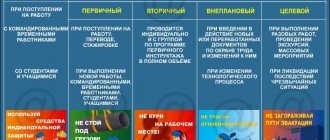Labor protection is an important segment that determines the life safety of personnel. The workplace should not have a negative impact on human life and health. An individual entrepreneur - employer must develop his own instructions on labor protection, which will guide him in the field of labor protection of his employees.
The development and approval of labor protection instructions must be carried out in accordance with the requirements of the Labor Code of the Russian Federation.
In accordance with the names of professions and the list of types of work approved by the employer, labor protection instructions for workers are developed. They are approved by order of the head.
Sections of the labor protection instructions:
- general safety requirements;
- safety requirements before starting work;
- safety requirements during operation;
- safety requirements in emergency situations;
- safety requirements upon completion of work.
Control over the timely development, verification, revision and approval of labor protection instructions is carried out by a labor protection specialist, or, in his absence, by the individual entrepreneur himself.
An individual entrepreneur - employer is obliged to provide his employees with safety and working conditions that comply with state regulatory requirements for labor protection.
Purpose of labor safety briefing
Familiarizing employees with labor protection requirements is the responsibility of all employers, in accordance with Article 225 of the Labor Code of the Russian Federation. The purpose of the labor safety briefing is to familiarize the new employee with the current structure of the organization: structure, labor regulations, equipment and production technology, labor protection and safety instructions, fire safety measures. This familiarization is mandatory for newly hired persons.
Responsibilities of the IP:
- control over the initial training of employees,
- issuance of workwear, safety footwear, personal protective equipment, hygiene (specialized equipment must be certified),
- equipment of employee workplaces in accordance with the requirements of legislation in the field of labor protection,
- being an employer, an individual entrepreneur must undergo training in the field of labor protection,
- organize staff training in safe working methods,
- organize regular checks of the level of knowledge of workers in the field of life safety at production sites,
- ensure systematic control over compliance with the work and rest regime of employees,
- organizing medical examinations,
- equipment for personnel, sanitary rooms, places of relaxation and recreation, areas for eating,
- organization of constant monitoring of compliance with labor protection legislation within the enterprise.
Introductory part
The legislation regulating the relations of citizens of the Russian Federation in the field of labor protection divides them into 2 categories: employers and employees. Employers are legal entities and individuals (IP) who hire workers to perform any work. Workers are the people who do these jobs. Each party is assigned a specific range of labor protection responsibilities.
The employer can be a large, medium or small enterprise, as well as an individual entrepreneur (IP).
All employers must provide safe working conditions and implement a set of labor protection measures for their employees. This must be done, even if there is only one employee. To do this, employers themselves or through authorized persons:
1. Create an occupational safety and health management system (OSMS) and ensure its effective operation.
2. Ensure the safety of production processes, buildings, equipment, materials, and workplaces.
3. Organize sanitary services for workers.
4. Organize the issuance of personal protective equipment (PPE), workwear, means for removing contaminants, and milk.
5. Provide methodological assistance to health departments: provide them with instructions, rules, regulations, magazines, help draw up lists for medical examinations, personal protective equipment, provide benefits, etc.
6. Organize training for workers and engineers, participate in knowledge testing commissions.
7. Conduct personnel training on occupational safety issues with the issuance of occupational safety certificates.
8. Organize mandatory medical examinations (preliminary, periodic, extraordinary, pre-shift).
9. Compile and submit labor safety reports.
10. Organize the investigation and recording of accidents (AC) and occupational diseases (OD), develop and implement measures that will avoid similar situations in the future.
11. Insure workers against accidents (AC) and occupational diseases (PD).
12. Develop rules, instructions, standards, and other safety documentation and bring them to the attention of employees.
Workers must:
1. Comply with safety requirements for your position or profession;
2. Use PPE, special clothing, and other protective equipment;
3. Complete occupational safety training and medical examinations on time and in full;
4. Immediately notify managers about dangerous work situations, deterioration of health, and accidents.
Who conducts occupational safety training?
The instruction is carried out by a labor protection specialist or another specialist who is assigned these responsibilities, according to the order of the manager. The person responsible for conducting the training must undergo occupational safety training at a training center, where they will issue an appropriate certificate. Without appropriate training of responsible persons, the instructions provided will not have legal force.
The employer's responsibilities include mandatory training of workers in labor safety rules in a specialized organization that has the appropriate license.
Organization of labor protection in a small enterprise
Of course, the organization of occupational safety management in small and large enterprises is different. At the same time, the requirements are not weakened, but management links are simply lost. For example, 3-stage OT status monitoring is replaced by 2-stage. Features of the OT service depend on:
• number of employed workers; • areas of activity of the enterprise (this affects the lists of types of work, equipment operated, etc.).
If a small enterprise employs 50 or more people, a separate OT service must be created. This mainly applies to:
• transport, manufacturing and construction small enterprises with a staff of up to 100 people; • scientific, technical or agricultural enterprises employing up to 60 people.
If there are fewer workers, the organization of labor protection in a small enterprise is carried out by:
• employer (company manager, individual entrepreneur) personally; • authorized employee (a separate position of safety engineer or part-time position is being introduced); • third-party accredited specialists or organizations under contract.
A special standard is devoted to the organization of labor protection in small enterprises - GOST R 12.0.009-2009 . Labor inspectors, employees of the fire service, Energy Supervision and other departments are always ready to provide employers with a complete list of occupational safety documentation required by each specific enterprise.
Procedure for conducting labor safety briefings
The employer is required to conduct induction training for a new employee on the day of hiring. New employees are instructed in a separate occupational safety room or other specially equipped room. In addition to introductory training, initial instruction is also provided. It is carried out directly at the employee’s workplace. There is no need to provide safety instructions only to citizens who work under a civil contract. They are not subject to labor and labor protection legislation.
To conduct occupational safety training, it is necessary to develop and approve appropriate programs. Based on legislative and regulatory legal acts, the employer independently develops a training program. The program must take into account the specifics of the activity.
To conduct unscheduled and targeted briefings, there is no requirement for the presence of programs; these briefings are situational.
Induction training is carried out before concluding an employment contract - one-time. Initial training is already at the employee’s workplace. Repeated instruction is carried out once every 6 months, but it can be more often - once every 3 months.
Conducting labor safety briefings includes familiarizing workers with the study of labor safety requirements, in accordance with the regulations of the organization, with dangerous and harmful production factors, with the use of safe methods and techniques for performing work. Labor safety briefings end with a test of knowledge and skills of safe work practices.
The final stage of the instruction is making entries in the appropriate journals.
The individual entrepreneur organizes training for blue-collar workers in providing first aid to victims. Training is conducted at least once a year. Newly hired employees undergo the specified training within the time frame established by the individual entrepreneur, but no later than one month after hiring.
BLOG
To the question: “Should I engage in individual entrepreneurship or not?” More and more often, our compatriots answer negatively, and the reason for such pessimism often lies not in doubts about the profitability of a business project, but in an understanding of the complexity of doing business within the framework of the activity of various inspections.
Despite constantly heard promises to rid businesses of unnecessary checks, in fact, entrepreneurs still spend a huge amount of effort preparing for meetings with fiscal authorities. The eternal question “who is to blame?” For now, let’s leave it out of the question and go straight to the question “What to do?”
In fact, we understand that we cannot completely leave to chance the issues of paying taxes, ensuring the safety of work, compliance with environmental standards, and many others. But if in large companies this is done by specially trained people, or even entire departments, then for micro-companies this entire burden falls directly on the manager.
In this article we will try to figure out what companies with a small number of employees should do in order to comply with labor protection requirements.
***
What requirements are established by labor protection legislation for small enterprises and individual entrepreneurs?
Obligations to comply with labor protection requirements arise only from the employer. If an individual entrepreneur does not have employees, then the requirements of the Labor Code in the field of labor protection do not apply to such an entrepreneur.
As soon as an entrepreneur hires an employee, he is obliged to comply with all legal requirements. Namely:
- Register as an employer with the Social Insurance Fund and Pension Fund;
- Maintain personnel records and develop personnel documentation;
- Provide subordinates with safe tools, raw materials and materials;
- Provide (if necessary) personal protective equipment and cleaning and disinfecting agents;
- Develop local documentation describing the occupational safety management system;
- Ensure safe working conditions in the workplace and conduct a special assessment of working conditions;
- If necessary, conduct medical examinations (upon hiring and periodically);
- Provide training for yourself and your managers in labor safety. All employees must be trained in first aid;
- Conduct briefings with subordinates, and, if necessary, internship before starting independent work.
It turns out not so little, especially considering that previously most individual entrepreneurs did not have to deal with the listed procedures. Realizing the upcoming volume of work, I involuntarily want to stop being an employer, and instead of employment contracts, enter into contract agreements with staff.
I would immediately like to warn against such a step, because it can be easily proven and punished.
What simplifications of procedures in the field of labor protection are provided for small companies?
The Labor Code in Article 217 establishes a distinction based on the number of employees. Companies with more than 50 employees must introduce the position of occupational safety specialist. If there are fewer employees, then we can assume that the director himself or an employee appointed by him is responsible for labor protection. You can also enter into an agreement with a company that will outsource your labor protection.
Sometimes it makes sense for companies to train all employees at a training center. Despite the obviously costly undertaking, the benefit comes from the fact that we can free such workers from undergoing on-the-job training and there is no need to organize internal training.
Thus, we can exclude the following documentation from local acts: An order on the creation of a permanent commission, a training program for workers, tickets for testing knowledge, protocols for testing knowledge, an order appointing those responsible for conducting training at the workplace, instructions on labor protection by profession and types of work, logbook for workplace training and a number of others.
Please note that induction training is still carried out for all employees, but this will need to be done once before the employee starts working.
When conducting personnel records, small businesses are allowed to refuse to adopt local regulations (internal labor regulations, regulations on remuneration, regulations on bonuses, and others). All excluded clauses can be taken into account when concluding an employment contract with an employee.
The standard form of such an employment contract was approved by Decree of the Government of the Russian Federation of August 27, 2016 N 858.
How is IP verified?
Scheduled labor safety inspections from January 1, 2021 will be carried out taking into account a risk-based approach. That is, the likelihood of harm to the employee is taken into account. In addition, until the end of 2021, there is a rule that provides for exemption from scheduled inspections of organizations classified as small businesses. However, you must understand that in addition to scheduled inspections, there are unscheduled inspections, the number of which has increased significantly recently. The reason for an inspector's visit for an unscheduled inspection is usually a complaint against the employer. The main cause of complaints traditionally remains disputes over employee benefits.
Occupational safety briefing log
Introductory briefing is recorded in the introductory briefing log, and on-the-job briefing is recorded in the workplace registration log. These briefing logs must be numbered, laced, sealed and issued to managers against signature.
Sample log of occupational safety briefing
Magazine
registration of induction training
Started March 1, 2021
Graduated _______20__
| date | Last name, first name, patronymic of the person being instructed | Year of birth | Profession, position of the person being instructed | Name of the production unit to which the instructee is sent | Last name, initials, instructor position | Signature | |
| instructor | instructed | ||||||
| 1 | 2 | 3 | 4 | 5 | 6 | 7 | 8 |
| 01.03.2017 | Ivanov Sergey Mikhailovich | 1965 | boss | Maintenance department | Skvortsov I.V. Occupational Safety Specialist | Skvortsov | Ivanov |
| 03.03.2017 | Petrova Tatyana Ivanovna | 1978 | accountant | Administrative department | Skvortsov I.V. Occupational Safety Specialist | Skvortsov | Petrova |
| 06.03.2017 | Ivanov Alexander Nikolaevich | 1981 | master | Production Department | Skvortsov I.V. Occupational Safety Specialist | Skvortsov | Ivanov |
Labor protection for individual entrepreneurs without employees
For an individual entrepreneur who does not use hired labor, labor protection is simplified. Occupational safety for individual entrepreneurs who do not use hired labor means caring for their own health and the health of their clients.
An approximate list of labor protection measures for individual entrepreneurs who do not use hired labor includes:
- occupational safety training within the general course,
- development of instructions for the safe conduct of work performed by an individual entrepreneur (even when working with a computer),
- fire safety training,
- electrical safety training,
- when using IP equipment, training in safety measures during its operation,
- inspection or inspection of this equipment,
- maintenance of fire extinguishers, protective equipment,
- when servicing individual entrepreneurs - issuing a health certificate and undergoing a medical examination.
The legislation allows scheduled labor safety inspections of individual entrepreneurs to be carried out no earlier than 3 years after their registration.
Rate the quality of the article. Your opinion is important to us:
Labor protection in individual entrepreneurs: rules and documents
Individual entrepreneurs in the Russian Federation (hereinafter referred to as individual entrepreneurs) are citizens who have created their own business and chosen one of the taxation systems.
Individual entrepreneurs can build their business alone, or they can hire hired personnel as labor resources. If a businessman himself carries out what he has planned, all his actions are subject to the tax and civil codes of the Russian Federation, and do not enter into the legal field of labor legislation.
As long as the individual entrepreneur runs his business alone, labor protection is not a responsibility for the individual entrepreneur. But from the moment the individual entrepreneur decides to hire an employee, even before he enters into the first employment contract with the employee, his responsibilities as an employer begin, as well as, possibly, his first mistakes.
There are two types of errors:
- Entrepreneur takes unnecessary steps
- Undertakes and fails to implement the legally established minimum of his duties
Note! Individual entrepreneurs do not submit labor safety reports to Rosstat. They do not have routine inspections, but there are some exceptions.
Exceptions to the moratorium apply to both individual entrepreneurs and legal entities from among small and medium-sized businesses (SMEs). Scheduled inspections are not carried out from January 1, 2021 to December 31, 2021, with the exception of individual entrepreneurs and SMEs with a high risk class and licensed types of work. The moratorium does not apply to unscheduled inspections. But the duration of the inspection cannot exceed 20 hours for small businesses.
Example. Florist Anna recently opened a boutique. One of the two couriers slipped while delivering flowers. The emergency room reported the incident to the labor inspectorate. Inspectors from Rostrud came to the boutique and began to check whether occupational safety documents were drawn up for IP Anna, whether occupational safety training was properly organized in the individual entrepreneur when hiring, and whether introductory briefing on labor protection and on-the-job training was carried out, which would have prevented the accident. As it turned out, Anna did not complete any of these activities, since she arranged for new employees, and they immediately got to work. Anna was fined 25,000 rubles under Part 3 of Article 5.27.1 of the Code of Administrative Offenses of the Russian Federation.
To prevent such mistakes, we have developed for you a small but important list of the main things to do on labor protection, which will save your business, your psychological health, and allow you to understand what the state, represented by the labor inspector, requires of you.
| № | Exercise | Rationale |
| 1 | Consider whether you need hired employees | Hire hired personnel only if you cannot perform the work yourself, or engage them under civil contracts. Insurance premiums, taxes, and possible fines can deprive you of not only profits, but also the desire to do business for many years. And in a serious situation, you may find yourself subject to criminal liability. Read more in our material Types of liability for violation of labor protection requirements |
| 2 | Consider whether you can cope with labor protection yourself, or whether you need to enter into an outsourcing agreement | You cannot include in the list of work provided under an outsourcing agreement functionality that is not specified in the professional standard of a labor protection specialist (Order of the Ministry of Labor dated September 4, 2014 No. 524n). Therefore, outsourcing can carry out introductory briefings, but initial training at the workplace or internship cannot be carried out. You will have to do this yourself until you have an assistant trained in occupational safety. Read the article - How to conduct occupational safety briefings |
| If you decide to carry out labor protection yourself: | ||
| 3 | Take labor safety training at the training center yourself | If you still decide to hire an employee, complete training on labor protection before you enter into your first employment contract. After all, induction training should only be conducted by an employer trained in occupational safety. Not all training centers have the “Occupational Safety and Health Training in Individual Entrepreneurs” program, but the basics of occupational safety and health are the same for everyone. The training center will tell you how to properly organize occupational safety training in individual entrepreneurs, how to conduct introductory and other occupational safety briefings, and what mandatory labor safety documents |
| 4 | Find out if medical examinations are required for your type of activity | If medical examinations are necessary, then issue a referral for a medical examination before concluding an employment contract. Find out why this is so important from our new article Medical examinations of employees: how to organize and formalize |
| 5 | Learn how to provide OT training and instruction. | Conduct induction training immediately after concluding an employment contract. How to conduct instructions, read in our material Occupational Safety Instructions. |
| 6 | Create documentation on labor protection | We have provided a comprehensive list of occupational safety documentation at the end of this article. |
| 7 | Issue PPE at your own expense | Read more about the issuance and care of personal protective equipment in our material Personal Protective Equipment |
| 6 | If opportunities allow, entrust occupational safety to your assistant | If this is not the case, organize labor protection yourself. As soon as you issue an order that you appoint your accountant or personnel officer to be responsible for labor protection, he needs to be trained in a 40-hour program at the training center. After this, your assistant can carry out individual occupational safety functions. But don’t call your assistant an OT specialist, otherwise you’ll have to pay for his professional retraining. Find out why this is so in our article Professional Standard for an Occupational Safety and Health Specialist: How to Apply When your business gets stronger and takes off, you can hire a full-time occupational safety and health specialist, and for this you don’t need to wait until your staff reaches 50 or more people . |
| 7 | Find out what fines are provided for violations of labor protection | Individual entrepreneurs, unlike legal entities, have benefits. In particular, the fine for labor safety violations is several times lower than for LLCs and other legal entities. Article 5.27.1 of the Code of Administrative Offenses of the Russian Federation is devoted to labor protection. Also study the criminal code - article 143. The entire useful table of fines is in the article - Types of liability for violation of labor protection requirements |
| 8 | Draw up a Regulation on the occupational safety management system and conduct an occupational risk assessment | For individual entrepreneurs, the provisions on OSMS are as mandatory as for legal entities, but some sections can be shortened. The structure of the occupational safety and health management system for individual entrepreneurs with up to 15 employees can be simplified, and how to do this is written in paragraph 19 of the Model Regulations on the Occupational Safety and Health Management System (approved by order of the Ministry of Labor and Social Protection of the Russian Federation dated August 19, 2021 No. 438n. But this can be neglected benefit, and draw up a regulation on OSH in full. Assessment of occupational risks is also a mandatory section in the Regulation on OSH. We described how to conduct an assessment in our article Occupational risks in labor protection: assessment algorithm and ready-made samples |










